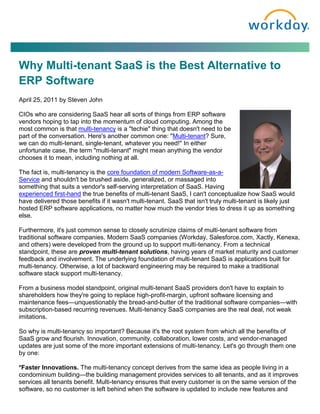
Why Multi-tenant SaaS is the Best Alternative to ERP Software
- 1. Why Multi-tenant SaaS is the Best Alternative to ERP Software April 25, 2011 by Steven John CIOs who are considering SaaS hear all sorts of things from ERP software vendors hoping to tap into the momentum of cloud computing. Among the most common is that multi-tenancy is a "techie" thing that doesn't need to be part of the conversation. Here's another common one: "Multi-tenant? Sure, we can do multi-tenant, single-tenant, whatever you need!" In either unfortunate case, the term "multi-tenant" might mean anything the vendor chooses it to mean, including nothing at all. The fact is, multi-tenancy is the core foundation of modern Software-as-a- Service and shouldn't be brushed aside, generalized, or massaged into something that suits a vendor's self-serving interpretation of SaaS. Having experienced first-hand the true benefits of multi-tenant SaaS, I can't conceptualize how SaaS would have delivered those benefits if it wasn't multi-tenant. SaaS that isn't truly multi-tenant is likely just hosted ERP software applications, no matter how much the vendor tries to dress it up as something else. Furthermore, it's just common sense to closely scrutinize claims of multi-tenant software from traditional software companies. Modern SaaS companies (Workday, Salesforce.com, Xactly, Kenexa, and others) were developed from the ground up to support multi-tenancy. From a technical standpoint, these are proven multi-tenant solutions, having years of market maturity and customer feedback and involvement. The underlying foundation of multi-tenant SaaS is applications built for multi-tenancy. Otherwise, a lot of backward engineering may be required to make a traditional software stack support multi-tenancy. From a business model standpoint, original multi-tenant SaaS providers don't have to explain to shareholders how they're going to replace high-profit-margin, upfront software licensing and maintenance fees—unquestionably the bread-and-butter of the traditional software companies—with subscription-based recurring revenues. Multi-tenancy SaaS companies are the real deal, not weak imitations. So why is multi-tenancy so important? Because it's the root system from which all the benefits of SaaS grow and flourish. Innovation, community, collaboration, lower costs, and vendor-managed updates are just some of the more important extensions of multi-tenancy. Let's go through them one by one: *Faster Innovations. The multi-tenancy concept derives from the same idea as people living in a condominium building—the building management provides services to all tenants, and as it improves services all tenants benefit. Multi-tenancy ensures that every customer is on the same version of the software, so no customer is left behind when the software is updated to include new features and
- 2. innovations. What's more, SaaS companies can deliver market innovations more quickly because they're not dealing with that disruptive practice of upgrading ERP systems every several years. This is especially important now, with users' increased expectations in the areas of mobility, consumer-like features, social media-type functionality, and more. *Stronger Communities and Collaboration. A single software version also creates an unprecedented sense of community where customers and partners share knowledge, resources, and learning. A Workday user conference is an entirely different experience than a traditional software conference because the community for sharing is limitless as everyone is on the same version. Even better, your time is spent talking about new functionality that can drive business productivity and innovation, rather than sharing tips on how to avoid a high-cost software upgrade. *Lower-Cost Model. A multi-tenant SaaS provider's resources are focused on maintaining a single, current version of the application, rather than spread out in an attempt to support multiple software versions for customers. How can a SaaS provider host thousands of single-tenant versions of the software while keeping its costs in line? It can't. Guess who'll end up paying for those costs? *Vendor-Managed Updates. Multi-tenancy makes it possible for the provider to update a single version of the software, often several times a year, for all customers. And these updates should be provided at no additional charge. The customer is relieved from IT upgrade projects, while the vendor can focus on what it does best, which is maintain its own software. Those are the top benefits of multi-tenancy, but in fact, multi-tenancy is interwoven into many aspects and benefits of real SaaS. To gain a broader picture of what true SaaS is comprised of, read my blog "10 Critical Requirements for Cloud Applications." - Steven Steven John, Workday's Strategic Chief Information Officer, works with customer CIOs and IT groups to help them realize the full benefits of Workday and cloud computing. Steven was most recently the CIO at H. B. Fuller Company, a specialty chemical manufacturer and early Workday customer. Steven was selected by Computerworld magazine as one of its Premier 100 IT Leaders in 2006, and received the CIO Executive Council Leadership award in 2009. He can be reached at steven.john@workday.com.
